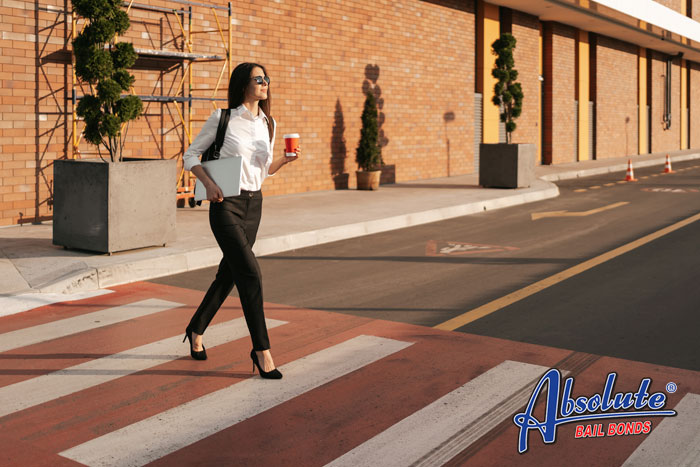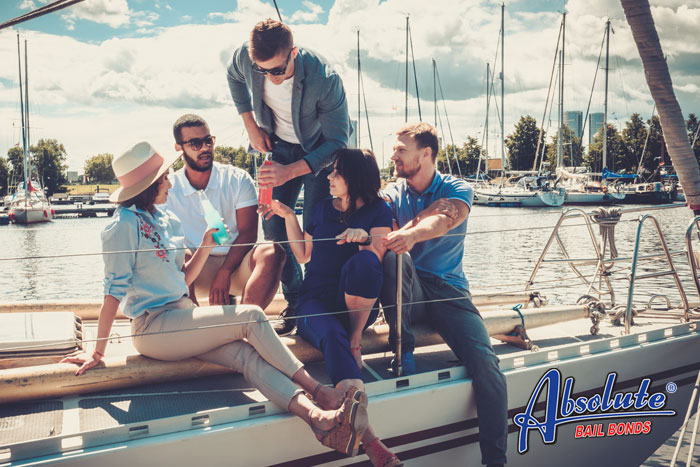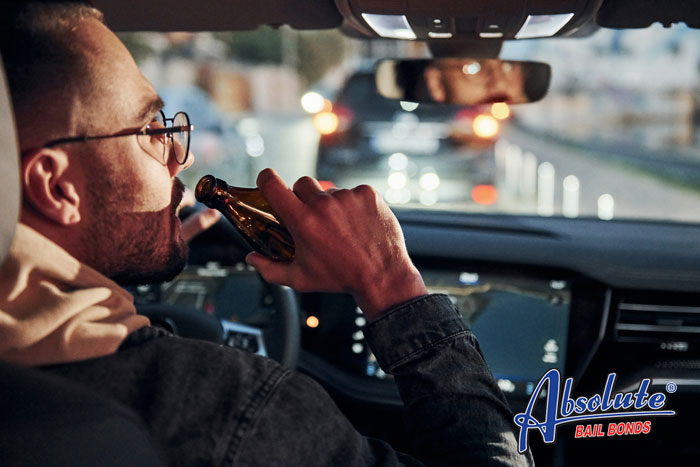
Crosswalk Safety in California
Walking to work means you don’t have to worry about getting caught in a traffic jam. It’s a great way to build some stamina while also burning a few calories. It also provides you with the means to start slowing down and develop a connection with the world you live in.
Just don’t think that walking to work is safer than driving yourself. A surprising number of California pedestrians are killed annually. According to the California Office of Traffic Safety, there were 972 pedestrian deaths in 2019. Approximately 22% of fatal traffic episodes in California involve a pedestrian. These alarming statistics prompted California lawmakers to pass the “Right-of-Way at Crosswalks” law.
The Right-of-Way law is written up in Code, Section 21950(a). When you read through the formal law, you’ll learn that drivers are legally required to yield to a pedestrian who is strolling through a crosswalk. The law requires that drivers yield to the pedestrian in both marked and unmarked crosswalks. The implementation of the law also requires that drivers use a little additional care when approaching a crosswalk and be on the lookout for pedestrians who may be about to step onto the street. If a pedestrian is stepping onto the street, the driver will have to stop to allow the pedestrian to safely cross the road.
Another issue that’s dealt with in the Right-of-Way law is passing while driving through a crosswalk. Passing while driving through a crosswalk is dangerous for several reasons, including that the passing driver may not see a pedestrian until it’s too late.
The interesting thing about California’s Right-of-Way law is that it’s designed to protect the rights of both pedestrians and drivers. Drivers do have the right away at crosswalks that are controlled with signals, provided the signal indicates that the driver can go. In this situation, the pedestrians are supposed to yield for drivers. However, drivers do have to wait for slow-moving pedestrians who may be struggling to reach the opposite side in a timely fashion, and the driver must be prepared to take safe and evasive action if a distracted pedestrian fails to notice the sign.
Drivers who are caught failing to adhere to California’s Right-of-Way law will likely receive a traffic citation which will involve a steep fine, points, and the possibility of having the state consider revoking their driving privileges.

What to Do if You’re Being Stalked
Every single year, approximately 7.5 million Americans become the victims of a stalker. If you suspect that you’ve attracted the attention of a stalker you must remain calm while simultaneously taking steps to protect yourself.
Don’t Dismiss the Threat
One of the biggest mistakes many stalking victims make is deciding that they are imagining things or that the situation isn’t all that serious. When it comes to a stalker, it’s best to be over-cautious. Being the victim of a stalker not only puts your mental health at risk, but it can also be life-threatening. The University of Gloucestershire conducted a six-month study that revealed that stalking was a component in 94% of the studied homicides.
As soon as you even suspect you’ve attracted the attention of a stalker, you need to take steps to protect yourself.
Block Your Social Media Accounts
Social media has made stalking easier than ever before. Routing posts provide an incredible amount of information that a stalker will use against you. When you feel that you’ve attracted the attention of a stalker, set all of your online profiles to private and stop posting updates, particularly updates that a stalker could use to figure out where you’re going and your routine.
Alert Loved Ones to the Situation
Even if you only have a funny feeling about someone, you should talk to your loved ones about the situation. Not only will they help you decide if you’re imagining things, but they can also take steps to make sure you’re protected. A perfect example of how alerting a loved one to the situation will help you out is that they’ll be willing to accompany you on errands. Not only is there safety in numbers, but the second pair of eyes means you will have a witness to the stalking which will strengthen your case if you have to press charges.
Start Keeping a Record
Pull out a notebook and start recording everything that relates to your stalker. This record should include gifts you’ve received, any time they’ve been in the same location as you, and all virtual and in-person conversations you’ve had with them. It’s a good idea to keep copies of these records in different locations. The data you collect will be a key piece of evidence against your stalker.
Get Serious About Personal Protection
You can’t afford to get casual with your personal protection. As soon as you feel that you’re becoming the victim of a stalker, you need to take a long look at your current situation and evaluate how you can make it safer. You need to lock your doors. You need to alert loved ones about where you’re going and when you’ll be back. Consider taking a self-defense class. Get into the habit of frequently checking in with loved ones. You may even want to consider staying with a friend or loved one until you can figure out how to resolve the situation.
Talk to the Police
As soon as you start to feel threatened by the stalker, it’s time to contact the police. The amount of protection they can provide will depend on your exact circumstances. Even if the situation hasn’t escalated to the point of you being able to obtain a restraining order or file charges against your stalker, contacting the authorities is always a good idea since it officially shows that you’re concerned about the situation and creates yet another record that strengthens your case. The police will also likely have some advice about additional steps you can take to protect yourself.
The most important thing to remember when you’ve attracted the attention of a stalker is to cut your ties with them and to trust your instincts.

Boating While Under the Influence in California
Everyone knows about the dangers and legal consequences of driving while under the influence, but we have a tendency to get lax when it comes to other situations. For example, while most of us would never dream of getting behind the wheel of our car after we’ve had a few beers, we have no hesitation when it comes to steering a boat as we drink.
One of the reasons we don’t give boating under the influence a second thought is because very little is ever said about the legal repercussions of doing so. The truth is, that if you’re caught driving a boat while intoxicated, your immediate future could be ruined.
The issue of boating under the influence in California is dealt discussed in Harbors & Navigation Code 655. The law states that:
(b) No person shall operate any vessel or manipulate water skis, an aquaplane, or a similar device while under the influence of an alcoholic beverage, any drug, or the combined influence of an alcoholic beverage and any drug.
(c) No person shall operate any recreational vessel or manipulate any water skis, aquaplane, or similar device if the person has an alcohol concentration of 0.08 percent or more in his or her blood.
(d) No person shall operate any vessel other than a recreational vessel if the person has an alcohol concentration of 0.04 percent or more in his or her blood.
(e) No person shall operate any vessel, or manipulate water skis, an aquaplane, or a similar device who is addicted to the use of any drug. This subdivision does not apply to a person who is participating in a narcotic treatment program approved pursuant to Article 3 (commencing with Section 11875) of Chapter 1 of Part 3 of Division 10.5 of the Health and Safety Code.
(f) No person shall operate any vessel or manipulate water skis, an aquaplane, or a similar device while under the influence of an alcoholic beverage, any drug, or under the combined influence of an alcoholic beverage and any drug, and while so operating, do any act forbidden by law, or neglect any duty imposed by law in the use of the vessel, water skis, aquaplane, or similar device, which act or neglect proximately causes bodily injury to any person other than himself or herself.
Getting caught boating under the influence isn’t a joke. You will be charged and face legal consequences. The exact consequences will depend on if it’s your first offense and exactly which aspect of Harbors & Navigation Code 655 was violated.
In most situations, boating under the influence in California is a misdemeanor offense. The maximum sentence for a first-time offense is six months to one year in jail and/or a potential fine of up to $1,000. It’s also possible that the judge will include substance abuse counseling and community service into the sentence.
In the right circumstances, a boating under the influence charge can become a felony offense. This usually happens if your actions resulted in someone getting hurt or if you caused a boating accident that created substantial property damage. If convicted of felony boating under the influence in California, your sentence could include 16 months to three years in jail.
The best way to make sure you don’t have to deal with the hassle of a boating under the influence charge in California is making sure that a designated captain who agrees to not to drink is the only person who piolet the boat.
Your boating adventures should be handled the same way you handle nights out with friends.

California Ear Bud Laws
Earbuds are awesome. They provide you with a way to tune out all the noise connected to the world and lose yourself in music, white noise, audiobooks, and podcasts. The earbuds fit snugly into your ear so that you don’t have to worry about anyone being disturbed by what you’re listening to.
What you might not know is that California does have some earbud laws that could impact you.
Cars and Earbuds
The first is you aren’t allowed to drive with earbuds in your ears. Not even if you’re using them to use your cell phone. The reason driving with earbuds in both of your ears is strictly prohibited in California is because lawmakers believe that the noise-canceling features of earbuds make it difficult to identify and react to outside stimuli that could prevent you from getting into an accident. It’s also possible that having the sound pumped directly into your ears, rather than coming from your radio speakers serves as a distraction.
There is some wiggle room. The law reads that you can’t restrict both ears, but doesn’t say anything about having an earbud in a single ear.
It’s worth noting that even if you don’t have anything pumping through the earbuds, you still can’t drive with two earbuds.
If you are caught driving while wearing earbuds, the experience will cost you. The traffic violation will cost $160 plus court costs, plus any other violations the traffic officer is able to cite you with.
California Bikes and Earbuds
Don’t assume that just because you’re on a bike, you can get away with wearing earbuds. The same law that applies to drivers also applies to bikers. You can have an earbud in one ear, but not in both. If you’re caught with both ears covered, you will be ticketed.

The Legal Ins and Outs of Street Racing in California
Street racing is fun. It’s exciting. It might even seem like a good idea. It’s also the type of fun that can land you in a great deal of legal trouble.
California lawmakers believe that street racing is reckless and dangerous behavior which is why they’ve created strict laws. The hope is that the laws are enough to convince you to give street racing a pass and look for a different, legal way, to get your kicks.
It’s important to understand that California lawmakers are cracking down on all types of street racing. You aren’t allowed to drag race, drift, or engage in a straight-up speed race while you’re on a public road. If you want to race, find a private racetrack.
At this point, street racing is a misdemeanor in California. Don’t assume that just because it’s a misdemeanor that you’ll get away with a reprimand.
The potential consequences of first-time offense for street racing in California include:
- 40 hours of required community service
- Losing your driver’s license for between 90 days and 6 months
- Serving between 1 day and 90 days in county jail
- A fine that ranges from $355-$1000
- Potentially having your vehicle impounded for 30 days (which means 30 days of impound fees)
You probably already guess, the consequences are worse after the first time you’re convicted of street racing in California.
If less than 5 years have passed since your first street racing conviction, the consequences can include:
- A mandatory 6-month suspension of your driver’s license
- Serving 4 days to 6 months in the county jail
- Paying fines that could range from $500-$1000
- High impound fees
Many street racers are caught because someone is hurt during the race which means medical personal and police arrive on the scene. Not only do the injuries bring law enforcement, but the injury also means significantly worse consequences to everyone who was busted on the street racing scene.
Street racers who are caught in a race that resulted in minor injuries can be sentenced to 30 days up to 6 months, have their license suspended, be required to do a significant amount of community services, and be issued fines of $500 to $1,000.
When a person is seriously injured as a result of a street race in California, you could be sentenced to 16 months to 3 years in jail, lose your driving privileges for a long time, and be required to pay as much as $10,000 in fines. It’s also likely that you’ll be named as the defendant in a civil lawsuit.
If someone passes away because of injuries sustained in a street race, you could be charged with vehicular manslaughter.
Additional charges that are frequently added to the street racing charges include:
- Reckless endangerment
- Reckless driving
- Evading the police
- Speeding
- Failure to yield
When you consider the potential consequences of street racing, it really is in your best interest to take the time to find a private race track where you can legally race to your heart’s content.

4 California Bike Laws you Probably Don’t Know About
Do you spend a lot of time biking in California? If so, there are some California bike laws you’re probably not familiar with.
Bikes and Crosswalks
Did you know that as a cyclist, you’re not supposed to stop your bike in the middle of a crosswalk? When you’re on a bike, you need to treat it the exact same way you would if you driving a car. Instead of pulling into the crosswalk, you’re supposed to stop at it. This gives pedestrians the opportunity and space needed to use the crosswalk.
Prep Your Bike For Nighttime Rides
If you’re cycling at any time between dusk and full-on morning sunlight, you need to have your bike properly equipped with enough equipment that motorists can easily see your bike. It’s not enough to simply rely on the reflectors the bike came with You should also have a red solid or flashing light attached to the back of your bike that can be easily seen from a distance of 500 feet away. On the front of your bike, you need to attach a white light that not only helps with your visibility but can also be seen from 500 feet away.
Ideally, you should wear clothing that has reflectors on it as well.
Keep One Ear Open
You see it all the time, cyclists cruising along with headphones in their ears, taking advantage of their ride to listen to audiobooks, songs, and podcasts. What you probably don’t know is that you can’t legally have two ears full of earbuds or be covered by a headphone while you’re cycling. CVC 27400 states that you must leave one ear uncovered while you’re riding your bike.
Stay Away from that Oversized Bike
If you think it’s okay to send your child out on the bike they haven’t quite grown into, or you’re tempted to purchase a massive bike you’ve been admiring each time you visit your favorite bike shop, you need to think again. California’s bike laws prohibit you from operating an oversized bicycle on public roads.
CVC 21201(c) states that, no person shall operate upon a highway a bicycle that is of a size that prevents the operator from safely stopping the bicycle, supporting it in an upright position with at least one foot on the ground, and restarting it safely.
Were you familiar with these bike laws?

Wet and Reckless in California
If you’ve never heard of a wet and reckless charge in California, you’re not alone. Very few people are aware of them. Most of the people who do know about wet reckless driving offenses are lawyers who specialize in DUI cases.
What is a Wet Reckless Driving Charge in California
A patrol officer won’t write a wet reckless ticket. The only way you’ll ever get such a thing is if you’ve been arrested for a DUI in California and your lawyer can talk it down to a wet reckless charge. The fact that it’s not a traditional driving violation is the reason so few people have even heard of wet reckless driving.
A wet reckless charge is a plea agreement the California lawyers use in drunk driving cases. They usually only apply the first time a person is involved in a DUI. The biggest difference between a wet reckless charge and a traditional DUI conviction is that the consequences connected to a wet reckless charge are milder than those attached to a DUI. In many cases, people find that having a wet reckless charge on their file doesn’t create as many problems when employers run a background check.
In the past, some lawyers haven’t been fans of wet reckless charges, but changes made in 2021 have altered their stance.
How a Wet Reckless Compares to a DUI
If you’re able to plea a DUI down to a wet reckless in California, there is no automatic suspension of your driver’s license, though there is an exception. If the DMV learns that your wet reckless charge resulted from a BAC of 0..08% they can still suspend your license, though the suspension might not last as long. It’s also important to understand that the charge will result in two points being added to your driving record.
A wet reckless charge doesn’t involve mandatory jail time. If the judge does sentence you to jail, the maximum amount of time you would serve is 90-days.
You’ll probably still be required to take a few DUI classes, but it’s normally far fewer than you’d have to take if you were charged with a formal DUI.
While there is still a probationary period connected to a wet reckless conviction, it’s significantly shorter. The probation for a wet reckless is generally one to two years, whereas for a DUI it’s three to five years long. This can have a huge impact on your life if you plan on moving out of state or doing much traveling.
Wet and reckless charges aren’t applicable in every single DUI situation. You’ll have to consult with a highly experienced DUI attorney to determine if this is the route you should take following a DUI arrest.

Tips for Kids Going Back to School
The threat of your young child disappearing when they go back to school is far greater than you imagine. According to Child Find of America, approximately 2,300 children are abducted every single day in the United States. The National Center of Exploited and Missing Children reported that in 2020, an estimated 1 in 6 missing children were victims of sex trafficking.
Stranger danger and abduction prevention lessons are something you and your children should always be working on. With the start of school just around the corner, now is the time to sit down with your child and review everything they know about stranger danger and staying safe.
While you’re shopping for school supplies, use this time with your child to review the rules you should already have in place regarding accepting rides from strangers.
The rules your child should already be familiar with include:
- Never get into a stranger’s vehicle
- Always staying several feet away from a stranger’s vehicle
- Knowing that if a person makes them feel even the slightest bit uncomfortable, that they should immediately seek out the assistance of a trusted adult
Abductors usually don’t bother with children who are traveling in packs, which is why it’s important to teach your child that they should always have a friend or two with them wherever they go. The more friends they have with them while walking home from school, playing in the back, and riding bikes, the safer they will be.
Now is the perfect time to teach your child how to be aware of their surroundings. This is something you should do by example. Put your phone in your pocket and actively survey your surroundings when you walk to and from buildings. Teach your child to notices is strange people are hanging around places like the playground. Teach them to be particularly aware if they notice that the same person shows up in multiple locations your child is at and to let you know about this person.
Make it very clear that it doesn’t matter if a stranger has candy, is saying they are lost/hurt, or has kittens/puppies to play with that your child is not to approach them. That their best course of action is leaving the immediate area and finding a trusted, familiar adult.
Teach your child to scream. If the worse does happen and a stranger approaches your child, the screams will cause the adult to quickly decide that your child isn’t worth the effort and they will flee the scene.
Don’t assume that just because your child is older that you no longer have to worry about abductions. According to the Missouri Child Identification and Protection Program, 81% of abducted minors were 12 years old or older.



